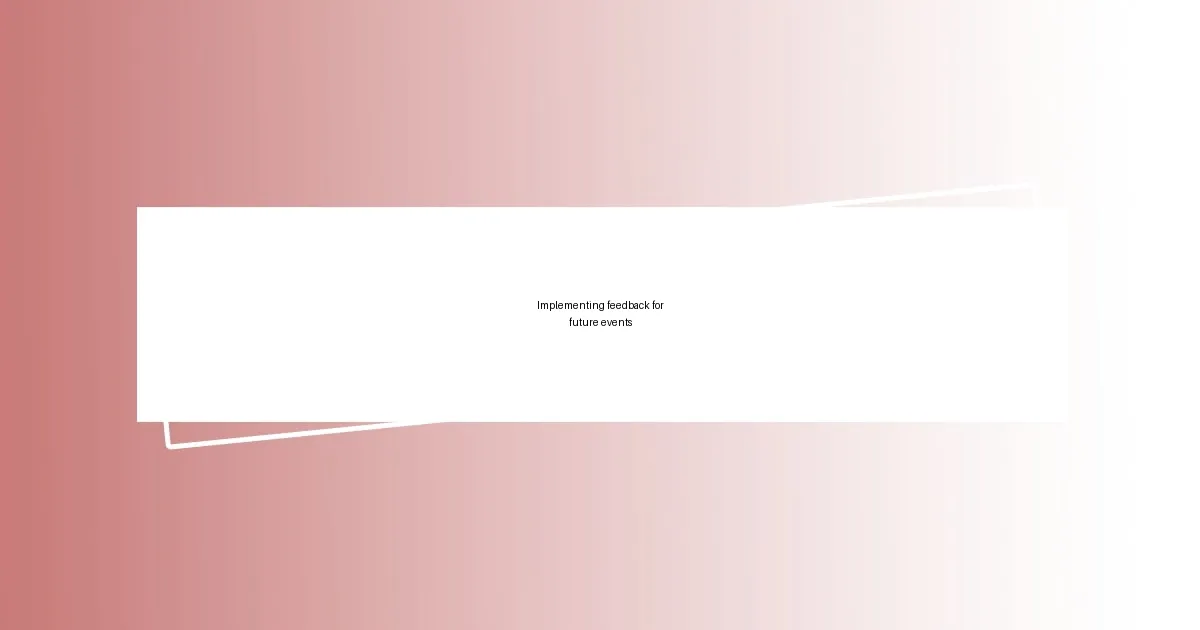Key takeaways:
- Setting clear feedback objectives helps streamline questions and gather actionable insights for future events.
- Using a mix of feedback methods—surveys, interviews, and focus groups—can yield diverse and meaningful responses.
- Engaging attendees during events through interactive elements and small group discussions fosters participation and deeper connections.
- Communicating changes based on feedback builds trust and encourages ongoing dialogue with attendees to enhance future experiences.

Setting clear feedback objectives
Setting clear feedback objectives is crucial for meaningful insights. When I first started gathering feedback, I remember feeling overwhelmed by the sheer variety of questions I could ask. This led me to wonder: what specific information would truly help me improve future events? By narrowing down my focus, I realized that having two to three clear objectives made it easier to ask targeted questions that yielded actionable responses.
I once attended a workshop where the organizers aimed to refine their content based on attendee satisfaction. They set objectives to identify which topics resonated the most and what changes participants anticipated. This clarity not only streamlined their survey but also encouraged participants to think critically about their experiences. As a result, the feedback they received was not only relevant but also deeply impactful.
Have you ever felt lost when reviewing feedback? It’s essential to hone in on what you genuinely want to learn. Setting objectives allows you to sift through the responses efficiently and recognize trends, making the process feel less daunting. In my experience, this clarity often sparked deeper conversations, revealing insights I hadn’t considered before.

Choosing the right feedback methods
When it comes to choosing the right feedback methods, I’ve learned that aligning them with your objectives is essential. I remember a particular feedback session where I relied solely on open-ended questions. While I was eager to gather qualitative insights, the responses were sometimes too vague to be actionable. It taught me that having a mix of feedback methods—both qualitative and quantitative—can provide a fuller picture. Think about varying the formats based on what you want to learn.
Here are some methods I’ve found effective in different contexts:
- Surveys: Quick and efficient for gathering quantifiable data.
- Interviews: Ideal for deeper insights and personal stories.
- Focus Groups: Encourages discussion and can reveal unexpected viewpoints.
- Online Polls: Perfect for instant feedback in larger groups.
- Feedback Boxes: Anonymity can lead to more honest and candid responses.
By experimenting with these diverse approaches, I discovered not only the richness of feedback but also how each method can foster engagement in unique ways. I can still visualize the buzz during a focus group I organized; the spirited debates revealed insights that simple surveys could never capture. This experience taught me that the right method can turn data collection into a dynamic exchange, enriching my understanding and ultimately benefiting my events.

Designing effective feedback surveys
Designing effective feedback surveys involves a balance between brevity and depth. Early on, when I crafted my first survey, I packed it with questions, hoping to cover every angle. However, I quickly learned that overloading the survey often led to participant fatigue and disengagement. I’ve found that keeping surveys concise yet thoughtful—typically around 5 to 10 questions—invites more meaningful responses. Focusing on fewer questions allows attendees to reflect more deeply, leading to insights that can impact future events profoundly.
The language you use in your surveys can also make a big difference. I remember a time when I asked a question that was overly technical, expecting thorough answers. Instead, my attendees seemed confused and distant in their responses. This taught me the value of simple language—asking questions that feel relatable creates a more inviting atmosphere where attendees are more willing to share honest feedback. Personalizing the tone—as if I were having a friendly conversation—helped attendees feel more connected to the survey and encouraged open dialogue.
Moreover, the timing of your survey can significantly influence the quality of feedback. I’ve experimented with different times for sending out surveys, and I noticed immediate differences in responses. Sending a survey right after an event, while the experience is still fresh, tends to yield richer and more immediate feedback. In contrast, waiting too long can result in vague recollections. Now, I make it a priority to reach out shortly after events, giving attendees a seamless avenue to express their thoughts and feelings while the memories are still vivid.
| Survey Element | Best Practice |
|---|---|
| Question Length | Keep it concise (5-10 questions) |
| Language Style | Use simple, relatable language |
| Timing | Send surveys promptly after events |

Engaging attendees during events
Engaging attendees during events isn’t just about what happens on stage; it’s about creating an inviting atmosphere where participation feels natural. I recall a breakout session I led where I intentionally incorporated interactive elements, like live polls during discussions. Watching attendees light up as their input shaped the conversation was a real eye-opener for me. It made me ponder: how often do we create spaces for attendees to influence the flow of the event? Simply adding interactive layers can transform a passive experience into a vibrant, collaborative one.
In another instance, I experimented with using small group discussions, allowing attendees to share their opinions in a more personal setting. I was pleasantly surprised to witness attendees who usually kept to themselves come alive in their smaller groups. It underscored for me the power of reducing the audience size to spark meaningful connections. Have you ever felt a little shy in a large group? I definitely have! By breaking the crowd into smaller, more intimate settings, we provide a stage for quieter voices to shine, enriching the event’s overall dialogue.
Moreover, the choice of icebreakers can set the tone for the entire event. I remember using a fun, quirky question that had everyone laughing and sharing their unique answers. That light-hearted moment created an instant bond among attendees, making them more willing to engage throughout the event. Isn’t it fascinating how a simple question can open doors to deeper connections? By prioritizing engagement strategies that resonate with your audience, you encourage a community spirit that can truly elevate their experience.

Analyzing and interpreting feedback
Analyzing feedback can feel overwhelming at first, but I found it surprisingly rewarding. After my last event, I went through the feedback with a keen eye, looking for patterns rather than focusing solely on the individual comments. I often ask myself: What are the common themes emerging from the responses? When I noticed several attendees commenting positively on the interactive segments, it clicked that this was an aspect I could expand upon in future events.
It’s essential to not just tally the scores but to read between the lines of qualitative feedback too. I love to highlight quotes that resonate because they capture the essence of the experience. For instance, one attendee wrote, “The breakout sessions made me feel like my voice mattered,” which struck a chord with me. It not only validates my approach but also emphasizes the need to foster an inclusive environment where all contributions are valued. Isn’t it fascinating how a single comment can illuminate the impact of our efforts?
Once I’ve sorted through the feedback, I like to visualize the data. Creating charts or graphs helps clarify what the numbers really say about attendee satisfaction. In one instance, I used color-coded visuals to show the highs and lows of the feedback. This method not only made it easier for me to digest the information but also allowed me to present it to my team in a way that sparked conversation. By transforming what could be dry statistics into engaging visuals, I believe we can motivate our teams to prioritize improvements based on firsthand attendee experiences.

Implementing feedback for future events
Implementing feedback for future events is where the magic really happens. I vividly recall an instance where I learned that attendees loved networking opportunities, but felt there weren’t enough structured activities. So, for my next event, I introduced speed networking. The exhilaration on people’s faces while rushing to connect with others was priceless! It made me think: how can we create environments where connections flourish while also addressing attendee needs?
Another interesting realization came when a few participants mentioned that they wanted more follow-up resources after the event. Inspired by this, I created a dedicated section on our website where attendees could access additional materials. It felt incredibly gratifying to respond to their desires, and their appreciation was evident. Have you ever received feedback that ignited a spark of creativity in your planning? For me, it was an eye-opener, showcasing how small tweaks can make a lasting difference.
Finally, I found that continuously assessing the effectiveness of the changes can be just as important as the implementation itself. After incorporating the speed networking and online resources, I sent out a quick survey specifically about these new elements. The feedback not only confirmed their success but also provided insights on future enhancements. This ongoing cycle of feedback reminds me that the journey doesn’t end after an event; it’s a continuous evolution. How do we keep improving if we don’t ask for opinions and take action? That’s the core of creating memorable experiences that resonate.

Communicating changes to attendees
Communicating changes to attendees is an essential part of maintaining trust and excitement. When I implemented feedback from my last event, I made it a point to send out an email detailing the adjustments we planned based on their input. I remember the thrill of seeing attendee responses light up my inbox. It felt like we were building a genuine connection, reassuring them that their voices truly matter.
I also found that using social media platforms to share these updates engages attendees in a different way. Once, I crafted a quick video update where I personally explained the new features for our upcoming event. I felt nervous showing my face, but the response was heartwarming—a flood of comments expressing enthusiasm made my day. Isn’t it incredible how using a friendly, personal touch can create a buzz and keep everyone in the loop?
Beyond just informing, I perceive my role as a guide. Once the changes are communicated, I often invite attendees to share their thoughts again, creating a dialogue that fosters ongoing engagement. In one instance, I welcomed feedback on a newly introduced panel format via a poll, feeling so stimulated by the variety of opinions. These interactions not only make the attendees feel valued, but they also allow me to continuously adapt and refine the experience. What if this ongoing feedback loop becomes the secret sauce that turns a good event into a fantastic one?














